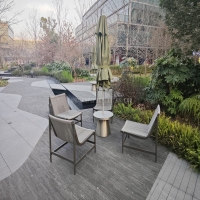Welcome to the website for landscape facilities products and knowledge.
How does the table’s design contribute to or detract from outdoor ambiance?
The subtle artistry of outdoor table design often goes unnoticed, yet it fundamentally orchestrates the atmosphere of open-air spaces. A table serves not merely as functional furniture but as the centerpiece around which outdoor experiences coalesce—transforming ordinary yards into enchanting retreats or, when poorly conceived, diminishing nature's inherent charm.
Material selection constitutes the primary dialogue between table and environment. Natural stone tables, with their geological textures and cool touch, establish organic connections to the landscape, their weathered surfaces reflecting dappled sunlight in mesmerizing patterns. Conversely, powder-coated metal tables introduce contemporary elegance through sleek lines and vibrant hues, though their industrial origins risk appearing stark against lush backdrops without thoughtful integration. Wood remains the perennial favorite—teak weathering to silvered perfection, acacia revealing intricate grains—each timber species telling a unique story through seasonal changes.
The table's form equally influences spatial perception. Circular designs foster intimate conversations, their curved edges encouraging fluid movement and unifying guests beneath overarching skies. Rectangular configurations lend structure to sprawling terraces, defining zones for dining and mingling while complementing architectural lines. The growing preference for mixed-material tables—perhaps concrete tops on slender iron legs—demonstrates how contrasting elements can create visual tension that energizes outdoor settings.
Height variations introduce dimensional intrigue. Standard dining tables anchor purposeful meal areas, while elevated bar-height versions cultivate casual standing gatherings, and low-slung coffee tables transform into fire-pit companions during twilight hours. This vertical diversity allows single spaces to accommodate multiple ambiances throughout the day.
Color psychology manifests powerfully outdoors. Earth-toned tables recede gracefully into natural surroundings, allowing vibrant tableware and floral arrangements to claim attention. Bold monochromatic tables make deliberate style statements—deep navy evoking moonlit sophistication, forest green echoing canopy shades—while translucent glass tops maintain visual lightness, preserving uninterrupted sightlines to landscaped beauty.
Practical considerations equally affect atmospheric quality. Slatted tables prevent rainwater accumulation, avoiding gloomy puddles that disrupt enjoyment, while solid surfaces provide dependable service during elaborate outdoor feasts. The presence of extendable leaves acknowledges entertaining flexibility, welcoming both spontaneous intimate dinners and planned celebratory gatherings.
Ultimately, successful outdoor table design achieves symbiotic balance—enhancing functionality without overshadowing nature's spectacle. It understands that the finest alfresco experiences occur when furniture harmonizes with environmental elements, where the table becomes not the focus but the facilitator of cherished moments beneath open skies.
Related search:

Recommendation
Metal structure rattan chair without armrests for single person, with woven seat and backrest.